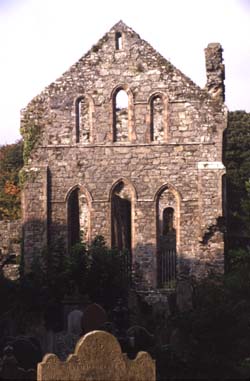 |
 |
 |
 |
 |
 |
 |
|
|
Cistercian Abbeys: GREY Name:
GREY Location: Greyabbey town County:
Down Grey abbey was founded in 1193 by Affreca, wife of John de Courcy and daughter of Godfred, king of Man. Tradition says that Affreca founded the abbey in thanksgiving for a safe landing after a perilous journey at sea. The abbey was colonised with monks from Holmcultram in Cumberland, with which it maintained close ties in the early years. The construction of the stone church began almost immediately. In 1222 and again in 1237 abbots of Grey went on to become abbots of Holmcultram. The abbey was situated in the Ards Peninsula, seven miles from Newtownards, at the confluence of a small river and the Strangford Lough. The Latin name of the abbey is Iugum Dei, which means ‘Yoke of God’. Little is known of the history of the abbey, though it appears to have been almost completely wrecked during the invasion of Edward Bruce (1315-18). No reliable sources concerning the value of the house survive, but Grey is not likely to have been prosperous. The abbey was dissolved in 1541 and in the same year part of the monastic property was granted to Gerald, earl of Kildare. The monastery was destroyed during the military operations of the Elizabethan era. In 1572, Brian O’Neill burnt Grey abbey in order to stop it being used as a refuge for English colonists trying to settle in the Ards Peninsula. In the seventeenth century the church nave was re-roofed and served as a parish church until 1778. In the late nineteenth century repairs were
executed by the Commissioner of Public Works. Unfortunately, an
excessive amount of concrete was used,
the crudity of which is still obvious today. The remains of the
abbey include the abbey church and some of the conventual buildings,
dating from c. 1193- c. 1250. The original plan of the monastery
can be followed with ease through foundations and earthworks.
The
abbot’s seat is preserved at Grey abbey, which is one of
the few monastic seats to have survived. It is fitted inside
a pointed arch and flanked by detached colonettes. Corbel tables
are also
a rarity in Ireland, but the Cistercians can boast two of them,
one at Tintern and one at Grey.
At Grey the corbels were inserted when the roof was raised, probably
in the early fifteenth century.
There are eight of them altogether, carved with oak leaves, human
figures and animal heads. An outstanding effigy of a ‘sword
seizing’ knight survives at Grey abbey, thought to date
from c. 1300. Also at Grey is an effigy of a woma carved in
high relief
and attired in thickly cut robes. Tradition relates that this is
Affreca, who was buried in the abbey, but the style suggests
that
the effigy originated in the fourteenth century, a hundred years
after her death.
|
